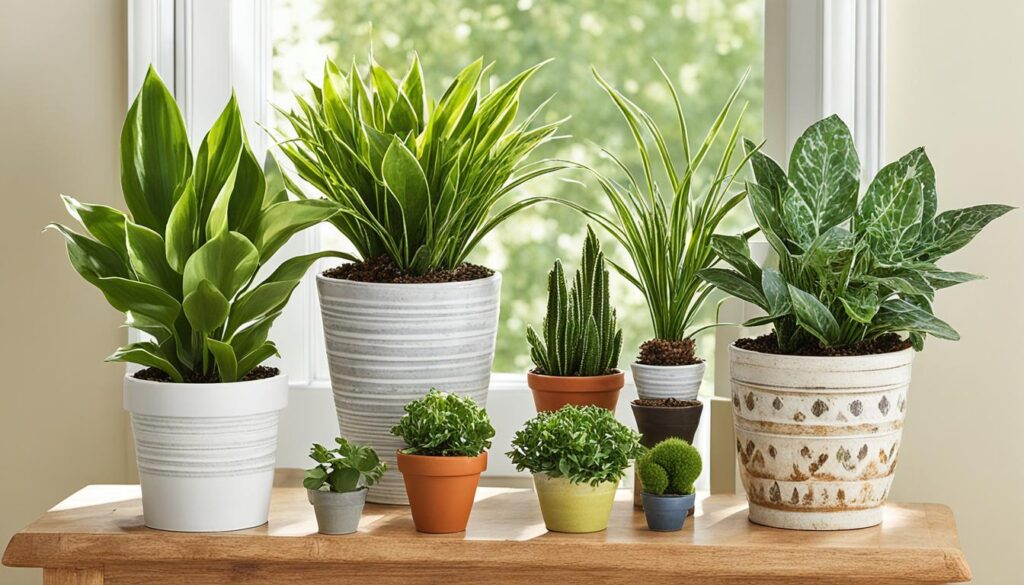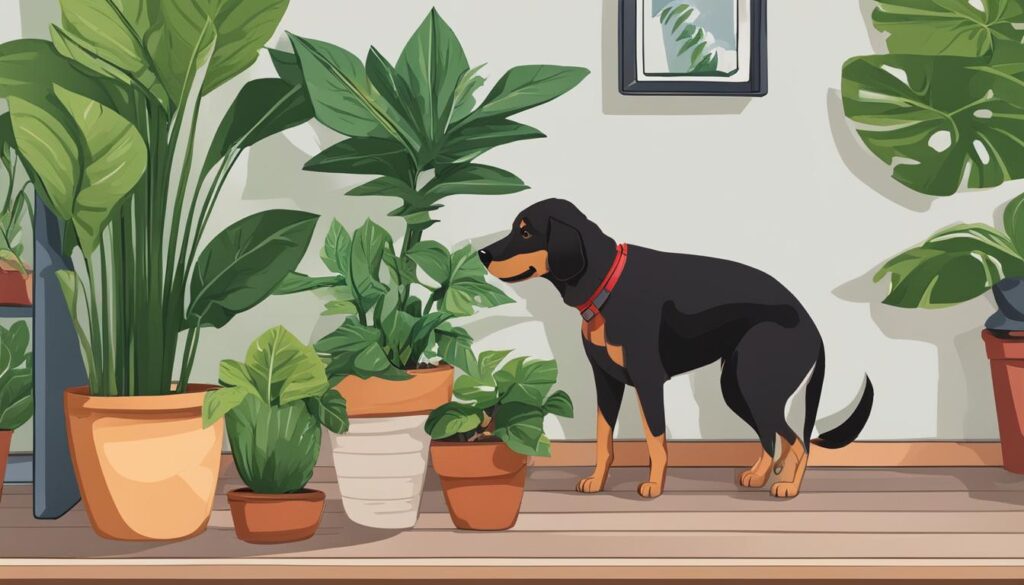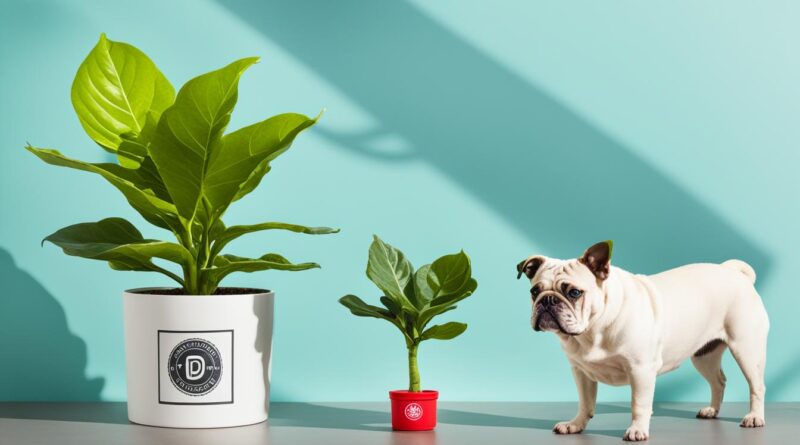Fiddle Leaf Fig Toxicity Risk to Dogs Explained
Are fiddle leaf figs toxic to dogs? Many pet owners may wonder about the potential dangers of having these popular houseplants in their homes. It’s essential to prioritize pet safety and be aware of the potential risks associated with certain plants. In this article, we will explore the toxicity of fiddle leaf figs to dogs and provide insights into pet safety when it comes to indoor plants.
Key Takeaways:
- Fiddle leaf figs are toxic to both dogs and cats due to the presence of a toxin called sapogenin.
- Ingestion of fiddle leaf fig leaves or stems can cause gastrointestinal upset and oral irritation in pets.
- While fiddle leaf fig toxicity is generally mild, it’s still important to prevent pets from accessing any part of the plant.
- Monitor pets for signs of ingestion and seek veterinary advice if necessary.
- Keep fiddle leaf figs out of reach of pets and consider pet-safe alternatives.
Side Effects of Fiddle Leaf Fig Ingestion in Pets
If a pet chews and eats fiddle leaf fig leaves or stems, they may experience certain side effects. The plant releases a white sap that can be irritating to the skin and eyes of pets. When ingested, it can cause stomach and intestinal issues, such as drooling, vomiting, decreased appetite, and pawing at the mouth. Severe cases may also lead to difficulty breathing, particularly in short-nosed breeds. It’s important to monitor pets for any signs of ingestion and seek veterinary advice if necessary.
To summarize, the side effects of fiddle leaf fig ingestion in pets include:
- Irritation to the skin and eyes
- Stomach and intestinal issues
- Drooling
- Vomiting
- Decreased appetite
- Pawing at the mouth
- Difficulty breathing (in severe cases, especially in short-nosed breeds)
If you notice any of these symptoms in your pet or suspect they have ingested a fiddle leaf fig, it is crucial to take prompt action. Monitor their condition closely and consult a veterinarian for proper guidance and treatment.
Quote:
“The ingestion of fiddle leaf figs by pets can lead to various side effects, ranging from skin irritation to gastrointestinal distress. It is essential to remain vigilant and prioritize your pet’s health and well-being by preventing access to this toxic plant.” – Dr. Emily Turner, Veterinarian
Preventing Fiddle Leaf Fig Ingestion:
To minimize the risk of fiddle leaf fig ingestion in pets, consider the following precautions:
- Keep fiddle leaf figs out of reach or in areas inaccessible to pets.
- Train your pet to “leave it” and offer appropriate alternatives for chewing and play.
- Use physical barriers like pet gates to restrict access to the plants.
- Supervise pets when around fiddle leaf figs, especially if they exhibit curiosity or a tendency to chew on plants.
Veterinary Care:
If you suspect your pet has ingested a fiddle leaf fig or any other potentially toxic plant, seek immediate veterinary guidance. Veterinarians can provide appropriate treatment and advice based on your pet’s specific situation.
| Signs of Fiddle Leaf Fig Ingestion | Action |
|---|---|
| Skin or eye irritation | Flush affected area with water and consult a veterinarian if symptoms persist. |
| Stomach and intestinal issues | Monitor your pet closely and contact a veterinarian if symptoms worsen or persist. |
| Difficulty breathing | Seek emergency veterinary care immediately. |
What to Do If Your Pet Eats a Fiddle Leaf Fig
If you suspect that your pet has eaten a fiddle leaf fig, it’s crucial to take appropriate action. Observe your pet for signs of mouth pain, drooling, lip smacking, or lack of appetite. If any abnormal symptoms occur, it’s recommended to contact a veterinarian immediately. They can provide guidance on the best course of action, including rinsing out the mouth and administering gastrointestinal protectants if needed. In case of uncertainty or emergency, contacting the ASPCA Pet Poison Helpline or a local vet is advisable.
If your pet has ingested a fiddle leaf fig, the first step is to assess their symptoms. Look for any signs of distress or discomfort, such as excessive drooling, pawing at the mouth, or vomiting. These symptoms may indicate that the fiddle leaf fig has caused an adverse reaction in your pet’s digestive system.
It’s important to contact a veterinarian as soon as possible to seek professional advice. A vet will be able to assess the severity of the situation and provide appropriate guidance. They may recommend rinsing out your pet’s mouth to remove any lingering plant residue and reducing the risk of further ingestion or irritation.
In some cases, a veterinarian may advise administering gastrointestinal protectants to help soothe your pet’s digestive system and prevent any potential complications. It’s essential to follow their instructions carefully and monitor your pet closely for any changes in behavior or symptoms.
If you’re unsure about the severity of the situation or unable to reach a vet immediately, contacting the ASPCA Pet Poison Helpline can provide valuable guidance. Their trained professionals can assess the situation and offer advice on the best course of action to ensure your pet’s safety.
Remember, prompt action is crucial when dealing with potential fiddle leaf fig toxicity in pets. By seeking professional help and following their recommendations, you can help protect your pet’s health and well-being.
Safety Tips for Keeping Fiddle Leaf Figs and Pets Separate
When it comes to ensuring the safety of your pets around fiddle leaf figs, prevention is key. By taking a few precautions, you can create a pet-friendly environment while still enjoying the beauty of these plants.
For dog owners, the best way to keep fiddle leaf figs out of reach is by placing them on high shelves or using adjustable pet gates as physical barriers. This prevents dogs from accessing the plants and reduces the risk of accidental ingestion. Training dogs to “leave it” can also help deter them from approaching the fiddle leaf fig. Positive reinforcement techniques, such as rewarding them with treats or praise when they listen to commands, can be effective in redirecting their attention.
Cat owners may need to take additional measures to keep fiddle leaf figs away from curious felines. Keeping the plant in a room that is off-limits to cats or placing it on a high shelf can prevent cats from reaching the plant. Cats are agile climbers, so it’s important to choose a location that is truly out of their reach. Providing cats with plenty of distractions and alternative chew toys can help redirect their attention away from the fiddle leaf fig.
It’s important to remember that each pet is unique, and what works for one may not work for another. Understanding your pet’s behavior and tendencies can help you determine the best safety measures for your specific situation.
Here are some additional safety tips for keeping fiddle leaf figs and pets separate:
- Regularly inspect the plant for any fallen leaves or branches that may be within reach of your pets.
- If you notice your pet showing interest in the plant, gently discourage them by using a firm “no” or redirecting their attention to a more appropriate toy or activity.
- Consider using plant sprays or repellents that are safe for pets. These can help create an unappealing scent or taste for pets, discouraging them from approaching the plant.
- Monitor your pet’s behavior around the fiddle leaf fig and seek veterinary advice if you suspect any ingestion or adverse reactions.
By implementing these safety measures and being proactive in pet-proofing your home, you can create a harmonious environment where both your pets and your fiddle leaf figs can coexist safely.
Pet-Safe Alternatives to Fiddle Leaf Figs
If you want to avoid the potential risks of fiddle leaf fig toxicity, there are several pet-safe alternatives to consider. These plants are non-toxic to dogs and cats, making them a safer choice for pet-friendly homes.
Pet-Safe Indoor Plants:
- Boston Ferns
- Spider Plants
- Peace Lilies
Researching any houseplant before bringing it into your home is important to ensure it is safe for your specific pets. By choosing these pet-safe alternatives, you can create a beautiful indoor environment while keeping your furry friends safe and healthy.

Comparison of Pet-Safe Alternatives:
| Plant | Pet-Friendly Rating | Additional Notes |
|---|---|---|
| Boston Ferns | 🐾🐾🐾🐾 | Low-maintenance and ideal for hanging baskets. |
| Spider Plants | 🐾🐾🐾 | Produces baby spider plants that can be propagated. |
| Peace Lilies | 🐾🐾 | Requires low to medium light and regular watering. |
Tips for Keeping Pets Away from Plants
Preventing pet plant ingestion and ensuring the safety of your beloved animals is essential. Here are some effective strategies to keep pets away from plants:
- Choose non-toxic plants: Opt for pet-safe indoor plants to minimize the risk of ingestion. Research plant toxicity before introducing them into your home.
- Keep plants out of reach: Place plants on high shelves or use physical barriers like gates to prevent pets from accessing them. This creates a safe distance and reduces the temptation to investigate.
- Train pets to “leave it”: Implement obedience training techniques to teach pets to avoid plants. Use the command “leave it” and reward them when they move away from plants, reinforcing good behavior.
- Provide alternative distractions: Keep pets engaged and redirect their focus by offering chew toys, puzzle feeders, or interactive games. This helps divert their attention away from plants and satisfies their natural instincts.
In addition to these tips, it’s crucial to ensure a pet-proof environment for houseplants:
- Secure loose leaves: Trim any loose leaves that may fall within reach of pets, reducing the risk of accidental ingestion.
- Use deterrent sprays: Some pet-friendly sprays can be applied to plants, creating an unpleasant taste or smell that discourages pets from approaching.
- Avoid dangling plants: Hanging plants can be enticing for pets to play with or nibble on. Opt for potted plants or secure hanging plants out of reach.
- Monitor plant placement: Regularly assess the positioning of your plants. Some pets may become more curious if they notice changes in their surroundings.
Remember, prevention is key when it comes to pet safety and plant ingestion. By implementing these strategies, you can minimize the risk and create a harmonious environment where pets and plants coexist safely.

| Benefits of Pet-Proofing Houseplants | Considerations for Pet-Friendly Indoor Plants |
|---|---|
| 1. Prevents accidental ingestion and potential poisoning. | 1. Choose non-toxic plants for peace of mind. |
| 2. Reduces the risk of gastrointestinal issues and oral irritation. | 2. Research specific plant toxicity levels for different pets. |
| 3. Promotes a safe and enriching environment for pets. | 3. Consider pet-friendly alternatives to toxic plants. |
| 4. Ensures the longevity and beauty of your indoor plants. | 4. Implement training techniques to deter pets from plants. |
Conclusion
Fiddle leaf figs can pose a safety risk to dogs and cats, necessitating the implementation of measures to protect our beloved pets. While the toxicity of these plants is generally mild, ingestion can cause discomfort and health issues in pets. To maintain a pet-friendly home while enjoying the aesthetic appeal of indoor plants, it is crucial to follow certain precautions. Keeping fiddle leaf figs out of reach, considering pet-safe alternatives, and employing strategies to deter pets from approaching plants are effective ways to safeguard our furry companions.
By placing fiddle leaf figs in areas inaccessible to pets and opting for non-toxic options, pet owners can create a harmonious living environment. Furthermore, training pets to understand and respect boundaries, such as using positive reinforcement techniques and offering alternative distractions, can redirect their attention away from plants. However, vigilance remains crucial; if your pet ingests a fiddle leaf fig or any potentially toxic plant, promptly seek veterinary advice for appropriate action.
Maintaining pet safety and a welcoming, green ambiance in our homes is achievable through proper plant selection and responsible pet care. By taking these steps, pet owners can ensure the well-being of their four-legged friends while enjoying the beauty and benefits of indoor plants.
FAQ
Are fiddle leaf figs toxic to dogs?
Yes, fiddle leaf figs are toxic to dogs. Every part of the plant contains a toxin that can cause gastrointestinal upset and oral irritation if ingested.
Are fiddle leaf figs toxic to cats?
Yes, fiddle leaf figs are toxic to cats as well. The sapogenin toxin found in the plant can cause gastrointestinal issues and oral irritation in cats if ingested.
What are the side effects of fiddle leaf fig ingestion in pets?
Pets that ingest fiddle leaf figs may experience symptoms such as vomiting, diarrhea, decreased appetite, drooling, and oral pain. Severe cases may lead to difficulty breathing, especially in short-nosed breeds.
What should I do if my pet eats a fiddle leaf fig?
If you suspect your pet has eaten a fiddle leaf fig, monitor them for symptoms of mouth pain, lack of appetite, drooling, or any other abnormal signs. Contact a veterinarian for guidance and follow their recommendations, which may include rinsing the mouth or administering gastrointestinal protectants.
How can I keep my fiddle leaf fig and pets separate for safety?
To ensure pet safety, keep fiddle leaf figs out of reach of pets by placing them on high shelves or using physical barriers like adjustable pet gates. Positive reinforcement training techniques, such as teaching pets to “leave it,” can also help deter them from approaching the plant.
What are some pet-safe alternatives to fiddle leaf figs?
If you want to avoid the potential risks of fiddle leaf fig toxicity, consider pet-friendly indoor plants such as Boston ferns, spider plants, and peace lilies. These plants are non-toxic to both dogs and cats.
How can I keep my pets away from plants in general?
To prevent pet plant ingestion, choose non-toxic plants, keep them out of reach, and use physical barriers like gates. Training pets to “leave it” and providing alternative distractions like chew toys can redirect their attention away from plants.
What is the importance of pet safety when it comes to fiddle leaf figs?
Ensuring pet safety is crucial when it comes to fiddle leaf figs. While the toxicity may be mild, it’s best to prevent ingestion and potential adverse reactions. By taking precautions and seeking veterinary advice when needed, you can maintain a pet-friendly home with plants.


